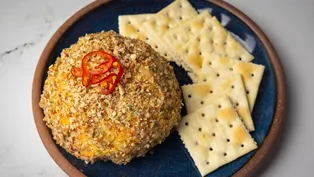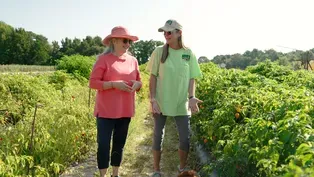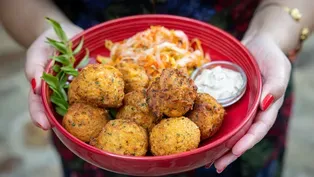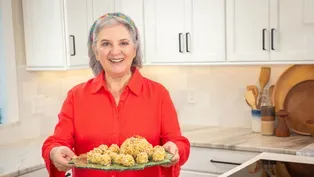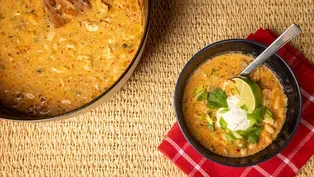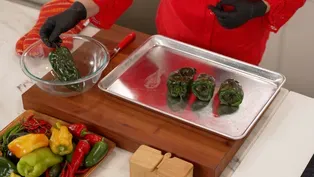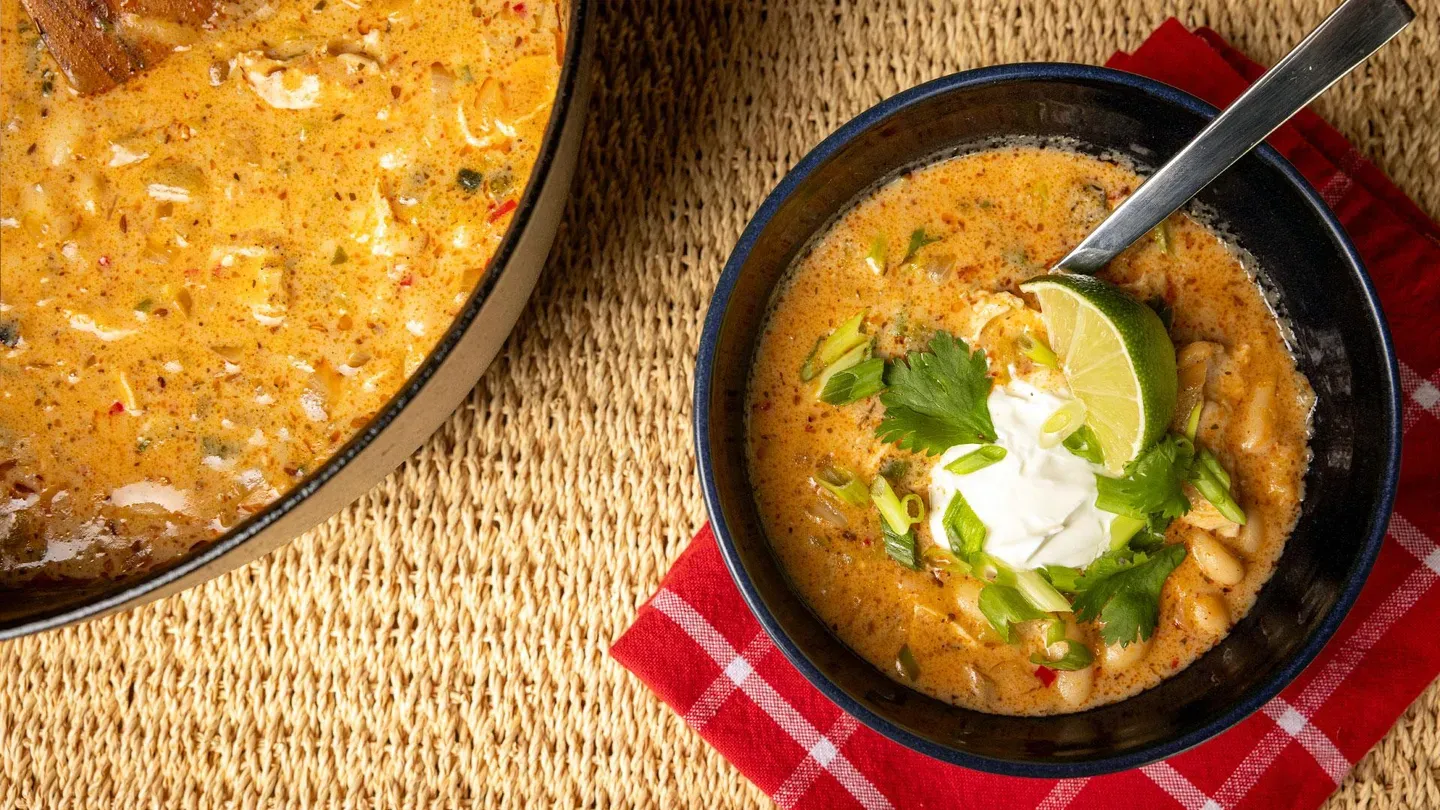

Warming Up to Hot Peppers
10/1/2024 | 26m 46sVideo has Closed Captions
Host Sheri Castle brings the heat with delicious recipes for hot peppers.
Sheri Castle spices up your next potluck with recipes for a candied jalapeño cheese ball and a warm stew of roasted green chile, chicken and white beans. She also shares a tip for roasting peppers right in your kitchen. Sheri visits Moore’s Produce in rural NC to see what it takes to grow hot peppers in the South, then cooks along with Emmy Award-winning documentarian and author Von Diaz.

Warming Up to Hot Peppers
10/1/2024 | 26m 46sVideo has Closed Captions
Sheri Castle spices up your next potluck with recipes for a candied jalapeño cheese ball and a warm stew of roasted green chile, chicken and white beans. She also shares a tip for roasting peppers right in your kitchen. Sheri visits Moore’s Produce in rural NC to see what it takes to grow hot peppers in the South, then cooks along with Emmy Award-winning documentarian and author Von Diaz.
How to Watch The Key Ingredient
The Key Ingredient is available to stream on pbs.org and the free PBS App, available on iPhone, Apple TV, Android TV, Android smartphones, Amazon Fire TV, Amazon Fire Tablet, Roku, Samsung Smart TV, and Vizio.
Providing Support for PBS.org
Learn Moreabout PBS online sponsorship- [Announcer] This program [soft music] was funded in part by The Forest at Duke, a retirement community in the heart of Durham, North Carolina.
With more than 350 residents, The Forest at Duke presents residents with ongoing opportunities to keep growing.
- [Sheri] Coming up [soft Latin music] on the Key Ingredient.
We're spicing things up with hot peppers, from a gentle kick to flaming hot, there's a pepper for every taste bud.
Join us as we visit a family-run farm in sunny eastern North Carolina.
Then I'll head into the kitchen to whip up a zesty roasted pepper and chicken stew, plus a sweet and spicy candied jalapeno appetizer.
And don't miss a journey through world-renowned island flavors with my good friend, Von Diaz.
That's next.
I'm Sheri Castle.
I write cookbooks.
I write for food magazines.
I cook, I teach, and I collect stories.
And my favorite stories are the ones behind our best loved home recipes.
[upbeat music] That smells good.
You think bears are gonna come.
- Probably out here.
- [Sheri] Oh, that's awesome.
I will go out and explore from the ground up, the best ingredients that go into some of our most beloved family recipes.
It's all about the food, the flavors, and finding the key ingredient.
[upbeat jazzy music] I always say that the best way to learn about a fresh ingredient is to talk with someone who grows it, which is why today we're headed to eat more fruits and veggies in sunny eastern North Carolina.
Stephanie Moore can explain how and why they grow dozens of different peppers on her family farm.
So, good to see you- on this good morning!
- Good to see you too!
- Wow, you ordered some great weather- for us.
- It's a beautiful day.
- Glad you guys are here.
This was my parents' farm.
[soft music] They farmed this land and my grandparents farmed at Selma, and me and my husband, he was a farmer when I met him.
And we kinda took over after we got married and started growing produce and vegetables.
- I know you grow all kinds of things, but I'm here to talk about peppers 'cause I hear you guys are tops in that and have a million different kinds.
So, can you show me the pepper patch?
- Sure, let's go.
- Alright.
[soft guitar music] - In this block here, we have about 4,300 peppers.
Each row holds 727- 25 plants.
- Wow!
- And then we put our mild peppers, which is about across the way over there.
I don't know how far, so, we don't have cross pollination.
- Gotcha.
So, how many varieties are you growing and is it vary from year to year?
- It varies from year to year.
This year I potted 89, but we lost five or six.
- 89 different varieties, not 89 peppers.
I've never been around peppers like this.
So, take me down a row and teach me some things.
So, I love how these look and you've got all these varieties and the names are just amazing to me.
- There is so many names in there, crazy names.
People ask me all the time, do you make this up?
And I don't.
[Sheri laughs] That's the way they're called.
- How do you know when they're ready to pick?
Do they get a certain size, a certain color?
What are we- looking for?
- We pick 'em by color.
So, even the small one, like even that we would pick.
Once it starts turning color, that's when we pick it.
- [Sheri] These look like little flying saucers.
And these are long and tapered.
But look at these.
These are scotch bonnets- right?
- Yes.
These are scotch bonnets.
And these aren't, you know, you can touch these without 'em burning your hand.
And on the right here is, and I'll pull one of these out so you can see.
This is the Jamaican scotch.
- [Sheri] Oh wow!
- So that is the traditional Caribbean scotch that's used.
- That is perfect.
It almost looks like a flower, doesn't it?
- Now, I hear that you grow what most people consider to be the hottest of all, the Carolina Reaper.
Is that one that people ask for by name?
- Yes, that's one that everybody wants and wants to try.
And I have to warn people sometimes, if you've never had this pepper, you should not try it, if you're not used to hots, 'cause it's Scoville heat unit is 2.1 2.2 millions.
- That's amazing!
- It's the hottest.
- The Scoville is that unit of measurement of just how hot it is.
- Right.
- Have you ever tasted one?
- I've had a slither of just the pepper.
- Well I see- you lived to tell about it- - It is.
- Yes.
- But one was enough.
- Yes.
- It looks so innocent, so beautiful.
And yet it lurks for us, doesn't it?
So, I'm noticing, you know, those were red.
We've got yellow.
We've got some of those brownish, chocolatey color ones.
Are these all Reapers?
- They are.
They're all Carolina Reapers.
And the heat is pretty much the same through all of 'em.
Typically your red is your hottest.
- Red's the hottest, okay.
- Chocolates are gonna be a little bit more smoky flavor.
- Really!
- And then your yellows and peaches are typically your fruitier undertones with the heat.
[upbeat music] - Stephanie, I've had the best time.
I never knew- - Me too.
- That there were this many kinds of peppers anywhere, much less in one patch.
We've learned what to look for, the different characteristics, from the not so hot to be really crazy hot.
I cannot thank you enough for sharing your patch, your farm, and your story with me.
I appreciate it.
- Thank you.
Thank you.
[soft music] - So, today I'm making a recipe that I've been making for almost 20 years.
It is a grilled chicken, white bean and hot pepper stew.
Now, the peppers aren't too hot.
They're actually a beautiful, mildly spicy green chili called a poblano, plus, lots of other good things.
Let's get started.
[soft music] The first thing I'm going to do is to put some butter in my pan.
[pan sizzling] Ooh, let that get nice and sizzly.
And I'm going to add some chopped onion and stir that around.
[utensil scraping] And to that onion as it cooks, I'm going to go ahead and put in my salt, so that that onion can start releasing its flavor, [utensil scraping] because I want it to get tender and beautiful and wonderful, but I don't want it to turn crispy.
Now, at different stages in this recipe, I'm going to be adding lots of flavor.
The first thing I'm gonna put in is a chopped red jalapeno.
Now, this is your opportunity to either dial up or dial back on the spiciness of this.
[utensil tapping] I think this is gonna turn out to be a really good midpoint that's going to appeal to a lot of people.
I have made enough of this stew over the years that you could float a boat.
And this is the version that I think makes most people happy time after time.
So, the second fresh thing I'm going to put in is a chopped fresh serrano.
[utensil tapping] Now, for my dried spices, I've got four delicious things.
The first is some ground up ancho chili.
And ancho has a very subtle heat and a beautiful fruitiness.
I'm gonna put that in.
I've got some great smoked paprika.
I have a little bit of Mexican oregano.
Yes, there's Mediterranean oregano and the Mexican, and they actually tastes pretty different.
The Mexican one is gonna be the best for this recipe.
And then I have some cumin seed.
I'm gonna give this just a minute.
I can smell the beautiful aroma of these spices.
I'm going to add some flour, because that's how I'm going to thicken this stew.
So, I'm just gonna sprinkle that over and stir it in [utensil scraping] to coat everything that is in the pot.
Now, I'm going to put two different kinds of liquid in here, and I'm going to start with some chicken stock.
Just pour that in.
[stock splashing] And then I have some whole milk.
Dairy is a wonderful way to sort of mitigate the heat of the chilies and give great flavor and texture to this stew.
I'm going to stir this and let it come to a gentle bubble [utensil scraping] until I can see that this starts to thicken.
[soft music] So, while I'm letting my mixture come to a bubble and thicken, let me tell you what I have here.
The first are white beans, and then I have some grilled chicken.
And then I have here some roasted poblano and I have roasted and chopped these.
So, now that I see good bubbling here in the pot, let me add these ingredients.
[beans splattering] So, in go my beans.
[bowl tapping surface] In goes my gorgeous roasted poblanos.
Here goes those gorgeous pieces of that smoky tender, beautifully seasoned chicken.
[soft music] And I'm just gonna stir this in, because each of these things are already cooked, really, it just has to warm through at this point.
[utensil scraping] Now, for one more little bit of heat and some acidity, I have a little bit of a jalapeno hot sauce.
It contains some salt and some vinegar.
So, it's adding all sorts of good things to the pot.
[soft music] Now, the last thing I do for this, which makes this stew [utensil scraping] really interesting, really thick and hearty and delicious, is I'm going to melt some cheese directly in here.
So, what I have is some shredded cheese, and I am going to toss this with some corn starch.
The reason I'm doing that is because that will help this cheese melt beautifully without separating in this hot stew.
And add it right in.
And look at this.
Look how quickly this came together.
So, I have served myself a big bowl of this gorgeous stew.
I'm gonna put some toppings.
Gonna start out with a little bit of sour cream.
I'm gonna put a good sprinkle of some beautiful chopped green onion, a few leaves of cilantro for those of us that love it.
And maybe my favorite thing, a squeeze of fresh lime.
And now, I'm gonna dig in.
Supper is served.
You've got that grilled chicken, you've got those white beans, you've got those beautiful roasted poblanos and all those spices.
This is a great bowl.
This is a great meal.
You're gonna love this.
My good friend, Von Diaz, was born in Puerto Rico, and grew up in Atlanta.
She's an award-winning documentarian, food historian and cookbook author who explores culture, memory, and ancestry.
Today she joins us in the kitchen to share vibrant recipes that celebrate global island cooking.
Well good morning, my friend.
- Hi Sheri.
- How are you?
- I'm so, good.
- You know, I was thinking as I was getting ready this morning, you and I have known each other a little- over 10 years.
- Okay.
- We've had dinner, we've hung out.
You know what we talk about?
We talk about how we're both fascinated that recipes and cooking can tell the stories of people's lives, their community, their culture.
We have that in common 'cause it's a universal thing.
- It is, it is.
And I was so excited when you told me we were gonna be working with spicy peppers, which I call chiles 'cause this is an ingredient that I did not grow up using.
- [Sheri] Right.
- But I learned a lot about chiles when I was working on my book, Islas, and I have all kinds of things to share.
- Well, that's good.
- Yeah.
- [Sheri] What are we making?
- Okay, so we are gonna start with Pikliz, which is a Haitian, starts out as a slaw and turns into a condiment- as it ferments.
- Really.
- And then we're gonna be making gato pima, which are lentil fritters, beautifully spiced lentil fritters from the Island of Seychelles.
- That is great.
Alright, how do we get started?
- This is gonna be really difficult.
We're gonna start by combining all of these ingredients.
- [Sheri] Okay.
Sweet peppers.
- Mm mm, yep.
And then we're gonna add this beautiful cabbage.
[dish tapping] We're gonna add these beautiful carrots.
[soft music] We got some bread onions here.
And then now we're gonna start adding these spicy chiles.
So, this is a sliced Scotch Bonnet pepper.
Now, we got some scallions, we're gonna throw in there.
And then here and I'm just doing this in whatever order- I want.
- Okay.
- I got some peppercorns.
- Uh huh.
- Some cloves.
- And then, of course, salt.
So, from here- - Uh huh.
- [Von] I'm gonna add some lime juice.
- [Sheri] Okay.
- And a glass of red vinegar.
- Vinegar.
- Yeah.
- Okay.
- So, traditionally, if I wasn't making this with you in your kitchen- - Uh huh.
- I might just actually toss this with my hands.
- Get your hands in.
- Do you crush it, just a little bit with- that salt in.
- Yeah.
- Little bit.
- You can kind of macerate it, you know.
- Uh huh.
- But basically it's ready to go from here.
- And you're putting it in a glass jar- - That's right.
- Because that's storage [objects knocking] and utility, right?
- Exactly.
So, now we're gonna finish up the Pikliz.
We're gonna [liquid pouring] just do it like that.
- Oh, that's smart.
- Get all those little- - And I'll get all those last guys in a moment.
[dish tapping] Just pour this on top.
And then- - So, that's gonna become a brine, almost like [object knocking] a pickling liquid.
- Exactly.
Exactly.
[top scraping] - Right, you wanna be sure it's good and secure.
[liquid shaking] - [Sheri] And give it the old shake.
- [Von] Yep.
That's it.
- All right, my friend.
Let me put this sit over side- - Okay.
- And then I hear fritters in our future.
- Yes.
- Alright.
[upbeat music] - [Von] We've got our lentils here.
[processor grinding] - [Sheri] Yep.
- And so now we're just gonna start adding little bits of water.
[processor grinding] - Mm mm, yeah.
[processor button clicks] - So, it will hold its shape.
- Mm mm.
- It's not too loose.
It's not too tight.
- Exactly.
[soft music] - So, we're gonna make these fritters now.
- Okay.
- I'm really excited for you to try them.
they're a bunch of really exciting ingredients, right.
We've got onions, we've got some cilantro that's chopped up.
We've got ginger, we've got garlic.
And then these are the aromatics, right?
- Okay.
- So, we've got cumin seed.
It's a lot of cumin.
It's actually very, very good.
Salt, of course.
black pepper.
This is minced curry leaves.
And then the last ingredient here is some red Bird's eye chiles.
So, we're gonna start mixing these things.
I'll give it an initial stir.
So, I just wanna get, in particular, the onions and, and the garlic and the ginger are the things that you wanna be really well combined - So, that everyone's gonna have a bite.
- Exactly.
And listen, this doesn't have to be perfect.
Let's just blend them up and then fry 'em in oil, because fried things taste good.
- I love the scoop idea, because they're gonna be more or less the same size.
- That's right.
- So, we'll just start- - [Sheri] Okay.
[scoop clicking] - Right about like that.
I think.
[scoop scraping] Like hummus ice cream.
- [Sheri] So, it looks we have enough to get started.
- [Von] Yep.
- I love that you've set up a fry station here.
- Absolutely, you gotta do it.
They're well formed, right.
- Uh huh.
- It's okay if they stick a little bit.
It's not a big deal.
And then just gonna set 'em right in- - the oil.
- I love how you're loading 'em in there.
You're not plopping them from on high.
- [Von] That is the number one thing that people do wrong with frying.
[soft music] - I like that you're spacing them apart, 'cause they're not gonna stick to each other.
They're not gonna stick to the bottom of the pot.
- [Von] That's right.
- [Sheri] And then what are we looking for?
- They are gonna brown.
So, this is a pro tip that I learned from a woman- in Curacao.
- Look at you.
- Instead of using a spatula, I just kind of move them around in the pan with these chopsticks, which do perfectly fine.
So, you don't want them to be too brown and then- - Want [indistinct] spoon.
- Yep, it's time to move these here.
[spoon tapping] - [Sheri] That's really fast.
Look how beautiful they are.
And there's no, I was interested, there's no dredge.
We didn't have to dust them in anything, they held together and made that gorgeous, even color, - They'll keep frying a little bit when they're off heat.
So, that's why I took them out when they were- - Okay.
- That color.
So, I'm gonna keep this here.
You can try one of these that are right here.
- Already.
- I think so.
- I'm gonna take the one that had personality.
Mm mm mm, alright, [fritter crunching] I'm getting ahead of the meal, I'm gonna do it later with the dipping sauce too.
[chewing] - [Von] Mm mm, yes, the theme of- - Oh my goodness.
- [Von] Aren't they tasty?
- Wow!
You know what it is?
It's like it's turned up the volume on everything.
I taste more cumin, more of the chile, more of the curry leaf.
It's all in there.
But that heat has just brought it all out, in the perfect level of crunch.
- I'm also seeing this in your hand right now.
It looks like a hush puppy.
- [Sheri] It does look like a hush puppy.
- Looks like hush puppy.
- Yeah.
Hush puppies wish they were this.
[Von laughs] Mm mm mm, these are so good as is.
But I hear there's a sauce, right?
- Yes.
Yes.
We're gonna make a spiced yogurt sauce.
- Oh gosh, let's do that.
- So, we're gonna make this super wonderful simple yogurt sauce.
That's to go with our gato pima.
The ingredients that are key to me are cucumber, lime juice.
We've got our spices here.
We've got garam masala, and then mint and cilantro.
So, yeah, here with my famous rotating bowl motion, [whisk scraping] I add the cucumber last.
And, and I like to let this sauce sit for a moment in the refrigerator.
- Look at our little tableau here.
- [Von] Ummm!
- I am loving this.
- I can't wait.
- Guide me through this.
If you were to walk up to this or serve this to friends, what would you tell them to do?
- So, depending on the level of comfort, so, we're friends, right?
I would start just right, right like that.
- Okay.
- [Von] That's the first thing I do.
- [Sheri] I would do that.
[fritters crunching] - Mm.
- That is so good.
- Mm mm mm mm.
- Mm mm mm mm.
- And they're like.
It's that lime juice, I think in the yogurt sauce that...
Okay, then I'm gonna do this.
So, even though these come from completely different parts of [indistinct].
This is from Haiti in the Caribbean.
This is from the Seychelles, which is in the Indian Ocean, tiny, tiny island near the Maldives.
But I believe that these things are gonna [spoon tinkling] go really well together.
- So, you're gonna put that right on top.
- I am.
- I'm watchin' friend.
- I think that the Seychellois would be down with this.
They love, love, love, love spicy food.
- [Sheri] This is hitting on all cylinders.
Mm mm mm, so good.
Just eat this and be happy every time.
- [Von] So, happy to feed you Sheri.
- Mm, thank you my friend!
We gotta do this again.
- Please.
- All right.
[soft music] - I'm about to show you a fun recipe.
It's for candied jalapenos.
Yes, spicy jalapenos in this beautifully spiced, sugary sweet syrup that turns into a thing that people affectionately call Cowboy Candy.
It is so easy.
Let me show you how to get started.
So, what I'm gonna do is, is I'm gonna take a big pile of jalapenos and cut them into little thin rounds.
I'm taking my Handy Dandy vegetable slicer, putting it on a bowl, wearing my gloves to protect my fingers from those peppery juices.
And I'm just gonna slice them into little rounds.
[slicer rattling] So, you just keep doing that with your knife or with your slicer until you have a bowl full.
And now I'm gonna show you how to make the syrup that brings it all together.
[soft music] So, the next easy thing is we're going to make our spiced sugar syrup, really simple.
This is cider vinegar.
And we're gonna add to that some sugar, quite a bit of sugar.
That's where we get the candy in our Cowboy Candy.
[bowl knocking] And then I'm gonna add four things to flavor it.
This is powdered ginger, celery seed, granulated garlic, and a little bit of turmeric.
And I'm just gonna stir this to help that sugar dissolve.
And we're gonna let it come to a boil and let it simmer for about five minutes.
That's all you have to do.
So, look at this after just a little bit of cooking.
See how it gets thick in syrupy and kind of falls off your spatula.
That's what you're looking for.
And then we're gonna add our sliced jalapenos.
[soft music] Now, I want you to let this come back up to a simmer.
Set your timer for four minutes and then we're ready to put 'em in the jars.
So, here we go.
Four minutes is up and these are ready to go in a jar.
Make sure these jars are really clean, squeaky clean, because we're not gonna preserve these.
We're just gonna stash 'em in the fridge and they'll keep for a long time.
But you want that really clean jar.
I've got my handy dandy funnel.
And then all I'm gonna do is I'm going to transfer our cooked jalapenos into a jar [spoon scraping] and come up pretty close to the rim.
Just keep at it here, a few more scoops.
And then we are gonna pour on some of this delicious syrup.
Come up to the top.
And then I want you [pot tapping surface] to take out your funnel and take something like a chopstick or a skewer and poke 'em around a little bit, 'cause we wanna make sure there are no little hidden air pockets in there.
And we wanna make sure that these are totally submerged.
So, if you need to top it off a little bit, please do.
Then we're gonna take your tight fitting lid.
We're gonna close the jars to what they call fingertip tight, like that.
And we're gonna let these sit undisturbed in a little corner of your cutting board undisturbed until they cool to room temperature.
And at that point you can put 'em in the refrigerator and they're going to keep for weeks.
Now, you can use this Cowboy Candy like you might use a relish or pickles or something.
But next I'm gonna show you one of my favorite recipes on how to make the most of your candy jalapenos.
So, I'm gonna use some of our Cowboy Candy to make a wonderful cheese spread.
It is so easy.
I have here some of our jalapenos and then I have Worcestershire sauce, a tiny bit of our brine, straight out of the jar of our jalapenos.
I have some very finely chopped green onions and some finely chopped pecans.
And I'm gonna stir this together with a tiny bit of mayo.
So, stir this around until it's well combined.
And then I'm gonna add two kinds of cheese.
Both of these are cheddars.
[utensil tapping] One is extra sharp and one is seriously sharp.
And you do wanna grate your own cheese.
You're gonna be so much happier if you grate it.
One on the large holes on a grater and one on the fine holes.
And that combination of textures really helps this come together.
And then we're just gonna fold it together.
We're just gonna give this [bowl tapping] some folding and some stirring until every bit of this cheese is coated with that delicious combination of our jalapenos, our crunchy green onions, our gorgeous pecans.
See how this comes together with just a little bit of stirring and folding.
[soft music] Now, I want you to cover this and put it in the refrigerator for a few minutes to firm up a little bit.
Now, you could serve this as a cheese spread, but I have a great idea of a beautiful way to serve it, to make it even more fun.
[soft music] So, look what I did.
I took that lightly chilled cheese mixture and I took my handy dandy [scooper rattling] little scooper here and I formed it into little bite-sized cheese balls.
I love to call these cheese bonbons.
And now for a little bit of a finish, I'm going to roll these in finely chopped pecans.
Now, you're going to get about two dozen of these little bites from that amount of our base mixture.
And I love how these cute little cheese bonbons are an updated version of the cheese ball that everybody loves at a party.
[upbeat music] I could not be happier with how this all turned out.
Look, we made the little ones.
We made one big one, we garnished it a little bit, and this is going to be a tempting treat the next time you have folks come over.
And when you make 'em, people are gonna talk about you in the very best way.
[upbeat music] So, when I made that delicious chicken stew, I mentioned that I had roasted those poblanos, and I'm gonna show you how to do that.
All you need to do to roast these is to put them on a tray.
There's no oil, there's no anything.
Now, if you have only one and you have an open burner, like a gas burner or a grill, you can do them one by one.
But it is far more efficient to do a lot at once on a tray.
And then we're gonna pop these babies under a preheated broiler, and that's how we get started.
[tray rattling] Well, look here.
They're charred and blistered all over.
I always tell myself when they look ruined, they're probably just right.
Now, what we're gonna do to finish cooking these is we're going to transfer them into a bowl that you can cover with clean film.
And during that steaming process, as they cool off, [plastic covering rattling] they're going to continue cooking a little bit and make stripping that skin off really easy.
So, I think these are ready to unwrap.
Now, look what happens.
That peel is ready to come right off.
And so, we're gonna wanna take out the stem and the seeds.
And if you sort of rotate that stem a little bit like opening a doorknob, a lot of that's gonna come out at once.
And what that has given me is now, this beautiful piece of roasted poblano.
Now, I did this with poblanos, but you can do this with any sort of a hot pepper or even a sweet pepper.
It is a great technique to extend the harvest, deepen the flavor, and give you a great product.
[soft music] Given the world of flavors, textures, and colors among peppers with a kick, there's sure to be one that's just right to be the key ingredient in your next recipe.
I've got a really important question.
- Yes.
- Who is this?
- [Stephanie] This is Penny.
- [Sheri] Penny, are you the queen of all you survey?
- [Stephanie] Say I am.
I've been around this farm for about 10 years.
[soft music] - [Announcer] This program was funded in part by The Forest at Duke, a retirement community in the heart of Durham, North Carolina.
With more than 350 residents, The Forest at Duke presents residents with ongoing opportunities to keep growing.
[bright music]
Candied Jalapeño Cheese Ball | Kitchen Recipe
Video has Closed Captions
Sheri Castle creates a candied jalapeño cheese ball that serves as a lovely party centerpiece. (6m 6s)
Video has Closed Captions
Sheri visits Moore’s Produce, where she witnesses more than eighty varieties of hot peppers. (3m 54s)
Gato Pima with Spiced Yogurt Sauce and Pikliz | Cook Along with Von Diaz
Video has Closed Captions
Sheri cooks along with Von Diaz, an Emmy Award-winning documentarian, food historian and author. (7m 38s)
Preview | Warming Up to Hot Peppers
Video has Closed Captions
Host Sheri Castle brings the heat with delicious recipes for hot peppers. (30s)
Roasted Green Chile, Chicken & White Bean Stew | Kitchen Recipe
Video has Closed Captions
Sheri shares her recipe for a warm stew of roasted green chile, chicken and white beans. (5m 27s)
Sheri Says: How to Roast Peppers
Video has Closed Captions
Host Sheri Castle reveals her technique for roasting peppers right in the kitchen. (1m 42s)
Providing Support for PBS.org
Learn Moreabout PBS online sponsorship